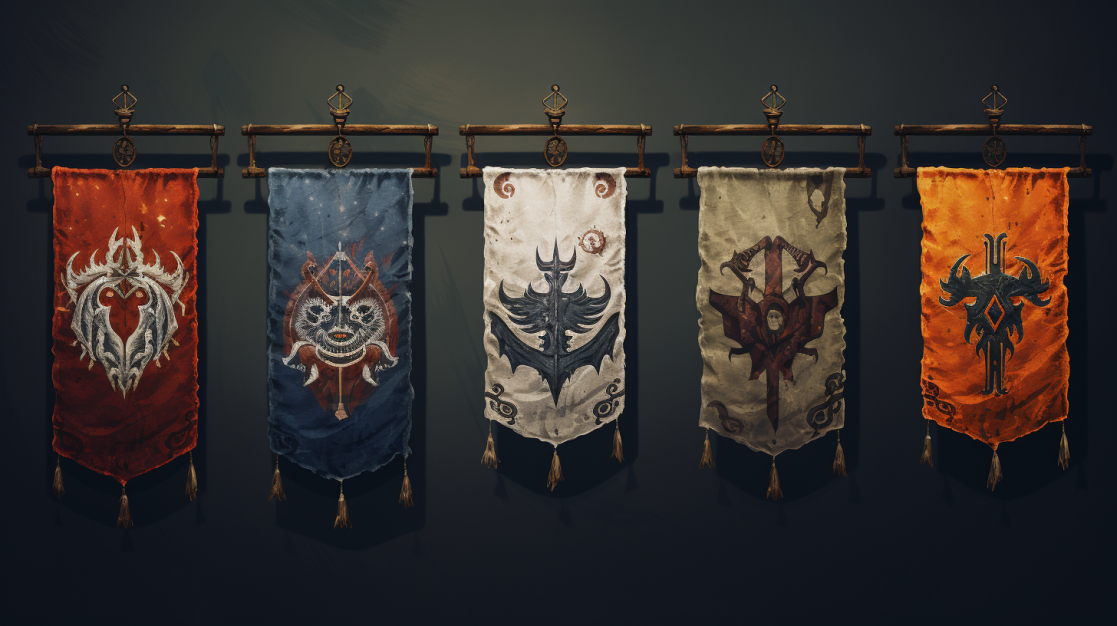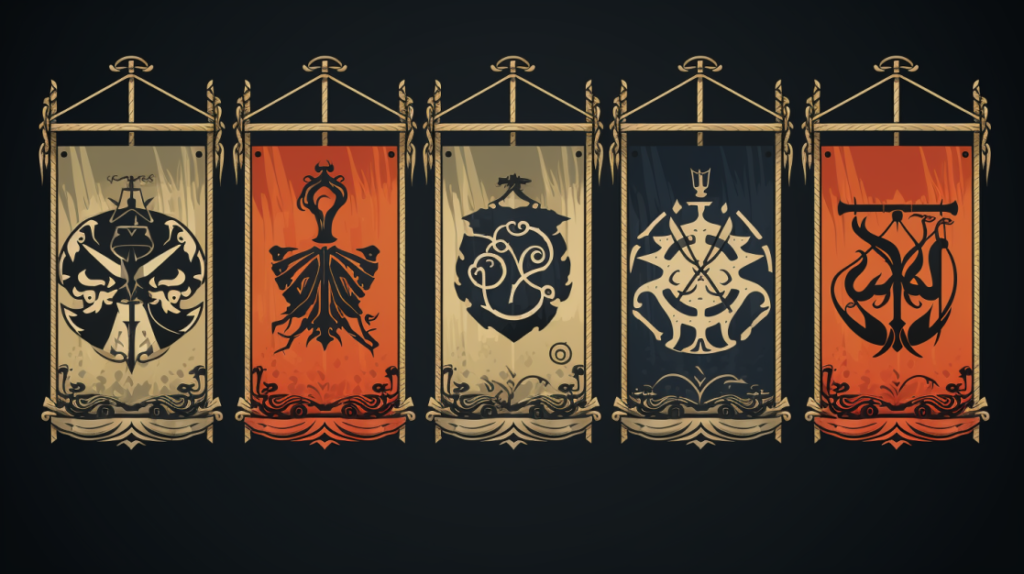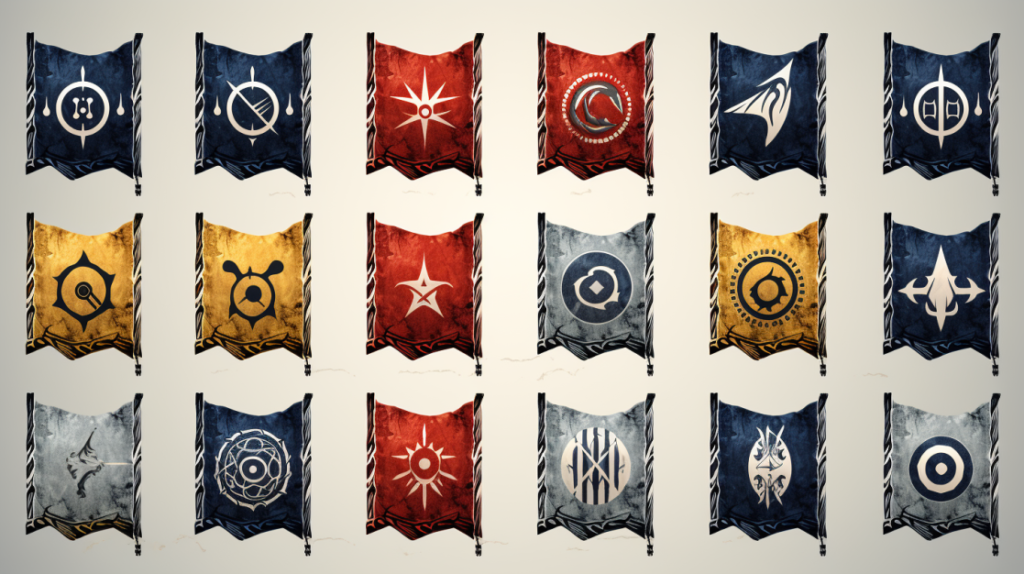Discover the Rich History Behind the Viking Flag

As a professional copywriting journalist, I am excited to explore the fascinating history of the Viking flag with you. The Viking flag is an iconic symbol of Viking culture, and its history spans back centuries. In this section, we will delve into its origins, evolution, meanings, and significance in Viking culture.
Key Takeaways:
- The Viking flag is an important symbol of Viking culture.
- The history of the Viking flag spans back centuries.
- This section will explore the origins, meanings, and evolution of the Viking flag.
Origins of the Viking Flag
Let’s start by exploring the fascinating history of the Viking flag. The Viking flag, also known as the Raven banner, was a standard used by the Vikings during the Viking Age, approximately from the 9th to 11th centuries. The banner was made of silk or linen and featured various designs and symbols, often reflecting the values and beliefs of Viking society.
The exact origins of the Viking flag are unclear, but its use can be traced back to the legendary Danish king, Harald Bluetooth, who is said to have used a similar banner during battles in the late 10th century. The banner depicted a raven, a powerful symbol in Norse mythology, which is said to have been the emblem of Odin, the god of war.
The banner continued to be used by Viking leaders, including the famous Norse explorer, Leif Erikson, who reportedly carried a banner with a red cross during his expeditions to Vinland in modern-day Canada.
The Symbolism of the Viking Flag
The Viking flag held great significance for Viking society, representing not only their identity but also their beliefs and values. The banner’s colors often held symbolic meaning; for example, the color red was associated with bloodshed and battle, while the color white represented purity and honor.
The symbols and motifs on the banner were also highly symbolic. For instance, the raven was associated with Odin, while the Valknut (a symbol of three interlocking triangles) was connected with the god, Odin, as well as with death and the afterlife. The use of runes, a system of writing used by the Vikings, on the banner also added to its symbolic significance.
The Viking flag was more than just a symbol of power; it was a symbol of identity, conveying the tribe or clan to which the bearer belonged, as well as their social status and values.
As the banner was carried into battle, it was believed to bring good fortune and victory to the Viking warriors.
The Symbolism of the Viking Flag
When we look at the Viking flag, we see more than just a piece of cloth with Nordic symbols. It embodies the essence of Viking culture and their beliefs. The flag’s colors, runes, and motifs all hold symbolism that conveys the Viking’s values and identity.
The Colors of the Viking Flag
The Viking flag’s colors are an integral part of its symbolism. The colors used in the flag are:
| Color | Symbolism |
|---|---|
| Red | Represents strength and bravery |
| White | Symbolizes purity and justice |
| Black | Signifies the unknown and the mysterious |
The combination of these colors creates a striking and bold statement that reflects the Viking spirit.
Runes and Motifs in the Viking Flag
The Viking flag also features runes and motifs that carry significant meaning:
- The Valknut, a symbol of Odin, represents the power of the Vikings’ chief god.
- The Aegishjalmur, also known as the Helm of Awe, was believed to protect the Vikings from their enemies.
- The Mjolnir, Thor’s hammer, symbolized strength, courage, and protection.
These symbols and runes were not just decorative elements; they held spiritual and mystical significance, which the Vikings believed would bring them power and protection.
The Significance of Viking Flag Symbolism
The Viking flag was an important tool in the Vikings’ attempt to establish their identity and values. Their culture valued strength, bravery, and honor, and the flag became a symbol of these qualities. It was an essential part of their rituals and ceremonies, and it played a significant role in Viking warfare, where it served as a rallying point and a source of inspiration.
“The Viking flag was more than just a piece of cloth; it was a symbol of power and identity that conveyed the Viking’s values and beliefs.”
Understanding the symbolism behind the Viking flag provides a glimpse into the sophisticated culture of the Vikings. It’s a testament to their creativity, spirituality, and their fierce determination to uphold their identity and beliefs.
Evolution of Viking Flag Designs
The Viking flag has a rich history, with different designs and styles emerging throughout time. From the iconic Viking ship flag to the controversial horned flag, let’s explore the evolution of Viking flag designs.
The Viking Ship Flag
The most recognizable Viking flag is the Viking ship flag, also known as the Raven banner. This flag was flown by Viking ships during raids and battles, and its striking design featured a black background with a white or red-colored bird, often a raven, at the center. This bird represented Odin, the god of war, death, and wisdom, and was a powerful symbol of Viking identity and victory.
| Viking Ship Flag | Symbolism |
|---|---|
 |
The bird on the flag symbolized Odin, the god of war, death, and wisdom. The use of this flag represented a strong and victorious Viking identity. |
The Viking Horned Flag
Another commonly recognized Viking flag is the horned flag, which features an image of a horned figure surrounded by various symbols and runes. However, the authenticity of this flag is highly debated among scholars, with some claiming that it was a modern invention and had no actual historical significance in Viking culture.
| Viking Horned Flag | Symbolism |
|---|---|
 |
The meaning of the horned figure on this flag is uncertain, as it does not appear in any Viking artifacts or literature. Some scholars believe that it was a modern invention and had no actual historical significance in Viking culture. |
Other Viking Flag Designs
Aside from the two well-known Viking flag designs, there were also other styles and variations that emerged throughout history. These include flags with various geometric patterns and symbols, as well as flags with animals such as dragons or wolves.
Overall, the Viking flag represents the culture and identity of a fierce and proud people. Its various designs and symbols capture the essence of Viking beliefs and values, making it an enduring symbol of Viking heritage and history.
Influence of the Viking Flag in Modern Culture
The Viking flag continues to capture the attention of modern culture, inspiring artists, writers, and enthusiasts around the world. The enduring popularity of the Viking flag is a testament to the deep symbolism imbued in its design, representing the strength and resilience of the Viking people.
One particularly notable example of the Viking flag’s influence can be seen in the world of sports. The Minnesota Vikings, a professional American football team, have adopted the Viking flag as their official team logo. The team’s uniforms prominently feature the iconic horns and deep purple and gold coloring of the Viking flag, evoking a sense of power and fierce determination.
The Viking flag has also made its way into popular literature and entertainment. From Neil Gaiman’s bestselling novel “American Gods” to Marvel Comics’ Thor series, the Viking flag has become a powerful symbol of strength and heroism, resonating with readers and viewers around the world.
“The Viking flag is more than just a symbol of the past. It’s a reminder of the strength and courage that we all carry within us. It represents the power to overcome adversity and emerge victorious, no matter what challenges we may face.”
Whether flying proudly over a ship or adorning a football helmet, the Viking flag continues to be a powerful symbol of strength, resilience, and determination. Its enduring popularity is a testament to the deep meaning and significance of its symbolism, inspiring people of all ages and backgrounds to embrace their inner Viking and conquer whatever challenges lie ahead.
Where to Buy Authentic Viking Flags
If you’re a fan of Viking history and want to own an authentic Viking flag, there are several options available to you. It’s important to be careful when purchasing flags, though, as there are many imitations out there that may not actually be historically accurate.
Here are some reputable sources and platforms where you can buy authentic Viking flags:
| Raven Banner | The Raven Banner is a website that specializes in creating handmade, historically accurate Viking flags. They use traditional materials and techniques to create high-quality flags that are both beautiful and authentic. |
|---|---|
| The Viking Dragon | The Viking Dragon is another website that sells authentic Viking flags. They offer a wide variety of designs and styles, from the classic ship flag to more modern variations. They also sell other Viking-themed merchandise, such as jewelry and clothing. |
| Etsy | Etsy is a popular online marketplace that features a wide variety of handmade and vintage items, including Viking flags. Many of the sellers on Etsy specialize in creating historically accurate Viking flags, so you’re sure to find something that fits your needs. |
No matter where you choose to buy your Viking flag, be sure to do your research and make sure you’re getting a high-quality, historically accurate product. With a little bit of effort, you can find the perfect flag to add to your collection and show off your love for Viking culture.
The Meaning Behind Viking Flag Symbols
Viking flags were adorned with a range of symbols that held great meaning in Norse mythology. These symbols were carefully crafted to represent the values, beliefs, and traditions of Viking culture.
Thor’s Hammer
One of the most recognizable symbols found on Viking flags is Thor’s Hammer, also known as Mjolnir. This powerful weapon was wielded by the god of thunder, Thor, and was often depicted on flags as a symbol of strength and protection.
The Valknut
The Valknut, also known as the Knot of the Slain, was an ancient Viking symbol that was often depicted on flags. It represented the connection between the gods and the fallen warriors who had died in battle and were welcomed into Valhalla.
The Triple Horn
The Triple Horn, also known as the Horn Triskelion, was a symbol of great significance in Viking culture. Its three interlocked horns represented the three roots of Yggdrasil – the world tree that connected all the worlds of Norse mythology. It was also associated with the god Odin and was often used as a symbol of wisdom and knowledge.
The Dragon
The dragon was a powerful symbol of strength and ferocity in Viking culture. It was often depicted on flags as a fierce warrior, breathing fire and brimming with power. The dragon was also associated with the sea and was often used on Viking ship flags to represent the dangers and challenges of the open waters.
“In Viking culture, symbols were more than just designs on a flag – they represented the very essence of their beliefs and values.”
Understanding the symbolism behind Viking flags offers a fascinating insight into the mindset and beliefs of these ancient people. Through their use of symbols, the Vikings were able to convey their ideals and aspirations, leaving behind a lasting legacy that continues to inspire and captivate us today.
Unveiling the Secrets of Viking Flag Rituals
As mentioned earlier, the Viking flag was not only a symbol of identity and pride but also played a crucial role in rituals and traditions. Let’s dive deeper into the different ways that Viking flags were utilized in their culture.
Flag-Raising Ceremonies
Flag-raising ceremonies were an important part of Viking culture. When a new chief or leader was appointed, a flag-raising ceremony would be held to commemorate the occasion. The ceremony involved hoisting the flag up a pole or staff while a group of people gathered around and sang Viking songs and recited poetry.
Battle Standards
The Viking flag was also used as a battle standard in times of war. The sight of a flag flying high would signal to Viking warriors that it was time to prepare for battle. The flag would be carried by a standard-bearer who was responsible for keeping it upright at all times. If the standard-bearer were to die in battle, another warrior would quickly take his place to ensure that the flag remained flying.
Role in Viking Warfare
The Viking flag played a significant role in warfare. Not only did it serve as a battle standard, but it also acted as a rallying point for Viking warriors. If a warrior became separated from his group during a battle, he could easily locate them by looking for the flag. The flag also served as a symbol of victory. When a battle was won, the flag would be taken as a trophy and proudly displayed.
Conclusion
The Viking flag was more than just a piece of cloth with a design on it. It was an integral part of Viking culture and played a crucial role in their rituals, traditions, and warfare. Understanding the significance behind the Viking flag adds depth and context to its rich history and symbolism.
Conclusion
Throughout this exploration of the Viking flag, I have gained a newfound appreciation for its rich history and significance in Viking culture. From its ancient roots to its enduring legacy in modern times, the Viking flag has remained a powerful symbol of identity and pride.
By delving into the origins of the Viking flag, we have uncovered how it evolved over time and the symbolism imbued within its design. The colors, runes, and motifs all conveyed deep meanings about Viking beliefs and values.
We also explored the evolution of Viking flag designs, from the iconic Viking ship flag to the controversial horned flag. Each variation represented different aspects of Viking culture and history.
Furthermore, we discovered how the Viking flag continues to captivate and inspire modern culture, from its presence in art and literature to its adoption by various groups. Its lasting impact is a testament to its enduring power.
If you’re interested in owning an authentic Viking flag, we’ve provided guidance on where to find them from reputable sources and platforms for purchasing high-quality Viking flags.
Finally, we unraveled the meanings behind the symbols commonly found on Viking flags and explored the rituals and traditions associated with the Viking flag.
In conclusion, the Viking flag represents a fascinating piece of history that continues to inspire and captivate us today. Its legacy will endure for generations to come, reminding us of the proud and powerful culture of the Vikings.
FAQ
What is the history behind the Viking flag?
The Viking flag has a rich history that dates back to the Viking Age. It was a symbol of identity and pride for the Norse seafarers and represented their warrior culture.
How did the Viking flag evolve over time?
The Viking flag went through various design changes throughout history. It began with simple designs, like the Raven banner, and later evolved into more intricate designs, such as the famed Viking ship flag.
What do the colors, runes, and motifs on the Viking flag symbolize?
The colors, runes, and motifs on the Viking flag held symbolic meanings. For example, the color red represented courage and strength, while the use of runes and motifs embodied the Norse mythology and beliefs.
Are there different variations of the Viking flag?
Yes, there are different variations of the Viking flag. One of the most well-known is the Viking ship flag, which depicted a Viking longship. Additionally, there is the controversial horned flag, which has become a popular representation of the Viking image.
How has the Viking flag influenced modern culture?
The Viking flag continues to captivate and inspire modern culture. It is often seen in art, literature, and even adopted by various groups and organizations as a symbol of strength and heritage.
Where can I buy authentic Viking flags?
If you’re interested in owning an authentic Viking flag, there are reputable sources and platforms where you can purchase high-quality flags. These include specialized stores, online marketplaces, and Viking-themed events.
What do the symbols on the Viking flag mean?
The symbols on the Viking flag hold significant meanings in Norse mythology. For example, Thor’s hammer symbolizes strength and protection, while the dragon represents power and ferocity.
Were there any rituals associated with the Viking flag?
Yes, there were rituals and traditions associated with the Viking flag. Flag-raising ceremonies were held to honor the flag and show allegiance. Flags also played a crucial role in Viking warfare as battle standards.
What is the significance of the Viking flag?
The Viking flag is a powerful symbol of Viking culture, identity, and heritage. It represents the legendary seafaring warriors and their values of courage, strength, and exploration.
Leave a Reply
You must be logged in to post a comment.

Comments on 'Discover the Rich History Behind the Viking Flag' (0)
Comments Feed